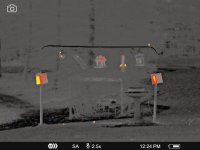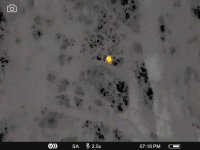I honestly thought my Pulsar imager was broken a couple of days ago.
The image was picking out animals fine ( in fact what was subsequently confirmed in the binoculars as a short eared owl flying over a hare was a highlight!) The background, trees and landscape was totally blurred out.
I changed settings, brightness, contrast, but where I'm usually able to see features to measure where the subjects are, there was just noise.
It wasn't a damp, misty day, and no rain as such but there was a pretty strong cold wind. Has anyone notice strong wind degrading the view?
I can believe it could play a factor in degrading the weaker heat from trees, bushes etc as any moisture in the air would be moving fast causing noise perhaps?
It's been milder since, and visual quality is back to normal

 www.mammalwatching.com
www.mammalwatching.com




















